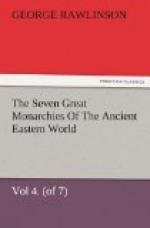These differences may be probably referred to the influence which was exercised upon the physical form of the race by the primitive or Proto-Chaldaean element, an influence which appears to have been considerable. This element, as has been already observed, was predominantly Cushite; and there is reason to believe that the Cushite race was connected not very remotely with the negro. In Susiana, where the Cushite blood was maintained in tolerable purity—Elymseans and Kissians existing side by side, instead of blending together—there was, if we may trust the Assyrian remains, a very decided prevalency of a negro type of countenance, as the accompanying specimens, carefully copied from the sculptures, will render evident. [Plate IX., Fig. 6.] The head was covered with short crisp curls; the eye was large, the nose and mouth nearly in the same line, the lips thick. Such a physiognomy as the Babylonian appears to have been would naturally arise from an intermixture of a race like the Assyrian with one resembling that which the later sculptures represent as the main race inhabiting Susiana.
Herodotus remarks that the Babylonians wore their hair long; and this remark is confirmed to some extent by the native remains. These in general represent the hair as forming a single stiff and heavy curl at the back of the head (No. 3). Sometimes, however, they make it take the shape of long flowing locks, which depend over the back (No. 1), or over the back and shoulders (No. 4), reaching nearly to the waist. Occasionally, in lieu of these commoner types, wo have one which closely resembles the Assyrian, the hair forming a round mass behind the head (No. 2), on which we can sometimes trace indications of a slight wave. [Plate X., Fig. 1.] The national fashion, that to which Herodotus alludes, seems to be represented by the three commoner modes. Where the round mass is worn, we have probably an Assyrian fashion, which the Babylonians aped during the time of that people’s pre-eminence.
[Illustration: Plate X.]
Besides their flowing hair, the Babylonians are represented frequently with a large beard. This is generally longer than the Assyrian, descending nearly to the waist. Sometimes it curls crisply upon the face, but below the chin depends over the breast in long, straight locks. At other times it droops perpendicularly from the cheeks and the under lip.15 Frequently, however, the beard is shaven off, and the whole face is smooth and hairless.
The Chaldaean females, as represented by the Assyrians, are tall and large-limbed. Their physiognomy is Assyrian, their hair not very abundant. The Babylonian cylinders, on the other hand, make the hair long and conspicuous, while the forms are quite as spare and meagre as those of the men.




